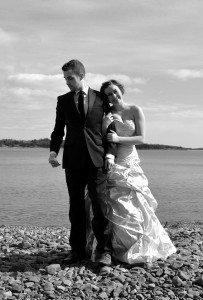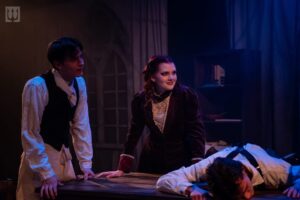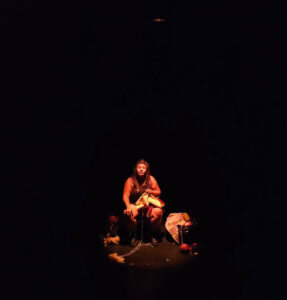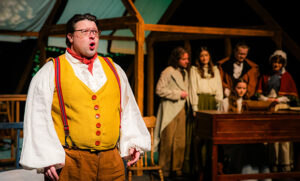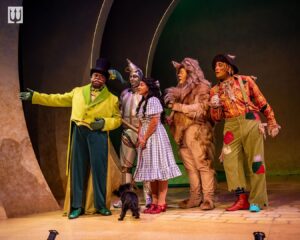taylor long & becca guilderson
Jason Robert Brown’s musical The Last Five Years (2001) tells the story of a relationship destroyed by insecurity, jealousy and resentment between a struggling actor (Cathy) and a successful novelist (Jamie). The story of their five year relationship is told simultaneously from both Cathy and Jamie’s points of view. Cathy’s narrative is in reverse chronological order and Jamie’s is in chronological order so that they only ever directly interact with one another when their narratives collide in the middle, on the day of their wedding. This means that Cathy’s most anguished moments are juxtaposed with Jamie’s most joyful ones at the beginning, while Cathy’s optimism having just returned from her first date with Jamie is countered by his decision to end their marriage at the end. This suggests that part of what makes the loss of a relationship so difficult is not just the painful and angry moments, but the memory of the former happiness and love that preceded them. The tragedy for Jamie and Cathy is how close they sometimes came to finding a healthy balance, yet their very human flaws, Jamie’s ambition and desire for accolades and attention, and Cathy’s dissatisfaction, self doubt and feelings of failure, keep getting in their way.
Mostly sung-through, Brown’s music is infectious and melodic and still has a distinctive contemporary feel to it, despite being thirteen years old. His lyrics beautifully capture both the inner emotions of two complex and (often) emotionally ravaged characters and their more colloquial dialogue with one another. He has some especially eloquent and heart wrenching lines that pierce directly to the heart of ardent familiarity for anyone who has ever known heartache. The band (Lisa St.Clair, Colin Matthews and Mariana Carrera) bring the nuances of Brown’s music to beautiful life and are at perfect balance with the actor’s singing voices.
Saints Alive Theatre Society’s production is double cast and I had the pleasure of seeing both of them yesterday at the Bus Stop Theatre in Halifax. Both casts give strong, and very different, performances. Taylor Long’s Jamie is quick-tempered and sullen when he doesn’t get his way, while Becca Guilderson’s Cathy is anxious and quickly dis-spirited, which makes them a volatile couple from nearly the beginning. Guilderson’s most incredible quality is her magnificent, powerful, belting singing voice, which gives Cathy a certain sense of sassiness and assertiveness. Long captures Jamie’s need for instant gratification very astutely. As his literary career is launched before age 24, he has a sharp impatience for Cathy to hurry up, and maybe not be as successful as him right away, but to hurry up and get over her insecurity and hurry up and be happy, and hurry up and fix their marriage— which ultimately leaves Guilderson’s Cathy even more depressed, lonely and frustrated with herself. Tamara Fifield is a more intense, introverted and quieter Cathy whose relationship with Jamie begins much more idyllic and then slides more slowly and subtly into disaster. Anders Balderston’s Jamie is joyful and tender and at first seems more bewildered than cocky about his success and we see clearly the moments where Fifield’s Cathy kills this Jamie’s burgeoning pride and exuberance in his work as she encounters more and more rejection from her own. Balderston’s voice soars gorgeously so much so that I think he manages to outdo Norbert Leo Butz in his rendition of “Moving Too Fast,” which is saying something. All four actors have heart wrenching moments and nicely convey the unraveling of a relationship that once, it is clear in both cases, was so full of love and friendship.
Due to its unusual configuration, The Last Five Years is usually considered to be a Concept Musical, which means that the director has quite a bit of thematic and creative freedom to choose how best to stage the musical so that specific central ideas and themes become more central for the audience than the narrative. In this instance director Laura Thornton roots the musical very much in Realism, more akin to a traditional Book Musical than a Concept Show. This works well in the scenes where the actors playing Cathy and Jamie are alone onstage and are rooted very clearly in a specific place with a specific audience, such as when Cathy sings “I Can Do Better Than That” in a car to Jamie while driving to her parents’ house. It becomes more murky as Realism when both actors are on stage together, seemingly sharing a scene together, yet they are actually inhabiting different periods in time.
So much of the crux of Jamie and Cathy’s failings in their marriage stem from their inability to communicate with one another effectively. Cathy is passive aggressive and Jamie becomes distant and deceitful. Yet, since their timelines are headed in opposite directions, in each scene one character is more frustrated and stubborn and one is more willing to compromise and still able to see the light at the end of the tunnel. This means that when both actors are onstage and the one closer to the end of the relationship is imploring the other to listen, it doesn’t make sense realistically for them to be given the cold shoulder from the character who is closer to the beginning of the relationship. Then, in each case, the silent character leaves the stage before the end of the scene and the other character does not react to being left, which is confusing. For example when Jamie sings “If I Didn’t Believe In You” it’s like there is an imaginary Cathy in Real Time that he is speaking to and then the Cathy From the Past being played by the other actor onstage, which is a time warp that throws the audience out of the Realism that Thornton grounds us in during other parts of the play. It would likely be clearer if, in these cases, the silent character existed in the same time as the singing character, as part of the memory, but that they didn’t come into the forefront until “The Next Ten Minutes” (the only true duet in the piece). This would also allow the characters to really fight for the attention of their partner using all the means available to them, including touch.
There are more subtle moments that can be grounded even more distinctly in Realism as well, for example, where does Jamie sing “Shiksa Goddess” and “Moving Too Fast”? Are they places where he can make huge grandiose gestures without feeling awkward or embarrassed? What are the three black boxes supposed to represent in these scenes? Is he actually dancing around somewhere or is his exuberance more indicative to how he’s experiencing the joy in his head? During “The Schmuel Song” why does Jamie have a real watch to give to Cathy but not a real copy of “the new Backstage”? If Cathy is Skyping with Jamie during “Summer in Ohio” is there a reason why she keeps going out of the frame of the computer where he presumably can’t see her? These may seem like nitpicking details, but they are jarring enough to pull the audience out of the Realist world of the play that Thornton has set up for us. I liked that Anders Balderston’s Jamie wordlessly addressed the embarrassment he felt wandering around with his accomplished literary friends at a party to toast his success carrying a nearly empty bottle of Jack Daniels. It’s these little nuances that help the audience feel like they’re clear on and familiar with the rules of the World of the Musical. In this case, the closer that the actions of Cathy and Jamie mirror the World as we understand and perceive it, the more grounded the play is in the Realism that Thornton is trying to create.
Similarly, I wondered about the role of the visual projections, which were sometimes a slideshow of the characters’ lives, sometimes a backdrop (but not a Realistic one) for the action, and sometimes seemed like random photos that referenced specific lyrics in the songs. For me they detracted from the sense of Realism and seemed unnecessary for clarity purposes as well. I liked the idea of the projected text messages, I would have liked to see the full screen of the phone including especially who they were to and from (mostly for clarity sake but also to give them that added realistic quality), and I also wondered about if and how the technology changes within those five years. It can be difficult to set a show like this one in any specific time, as there is one moment especially that is now quite dated: Cathy’s nonchalant line “who you might say looked like Tom Cruise” makes WAY more sense if it is happening in 1997 than it does if it’s happening in 2010. Also, literary critic John Updike, who is referenced in the show, passed away in 2009. Yet, I think there is room for fun to choose a specific five years span for this show and to have subtle allusions to time passing in wardrobe and technology choices.
In all, The Last Five Years is a poignant piece of musical theatre given passionate and heart rending life at the Bus Stop Theatre. All of the artists involved are in different stages of their careers and each one represents a great hope for the future of musical theatre here in Halifax and for that I am very grateful.
The Last Five Years closes tomorrow (April 5th) with two performances. Cast 2 (Balderson and Fifield) play at 3pm and Cast 1 (Long and Guilderson) play at 7:30 at the Bus Stop Theatre (2203 Gottingen Street).
Tickets available online at http://saintsalive-tl5y.eventbrite.ca/ or at the door (cash/credit only)
Adults – $15
Students/Seniors/Arts Worker – $12

